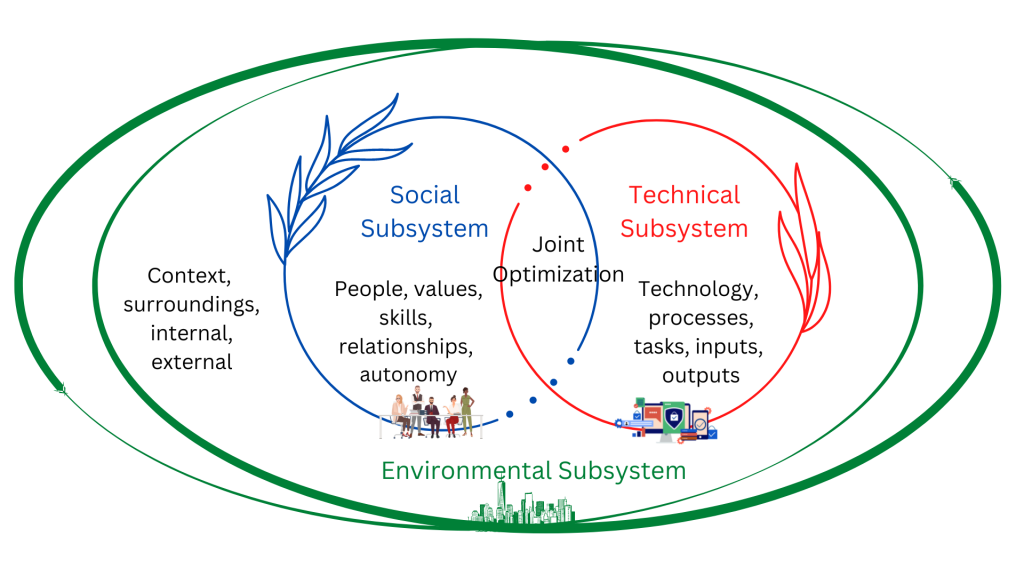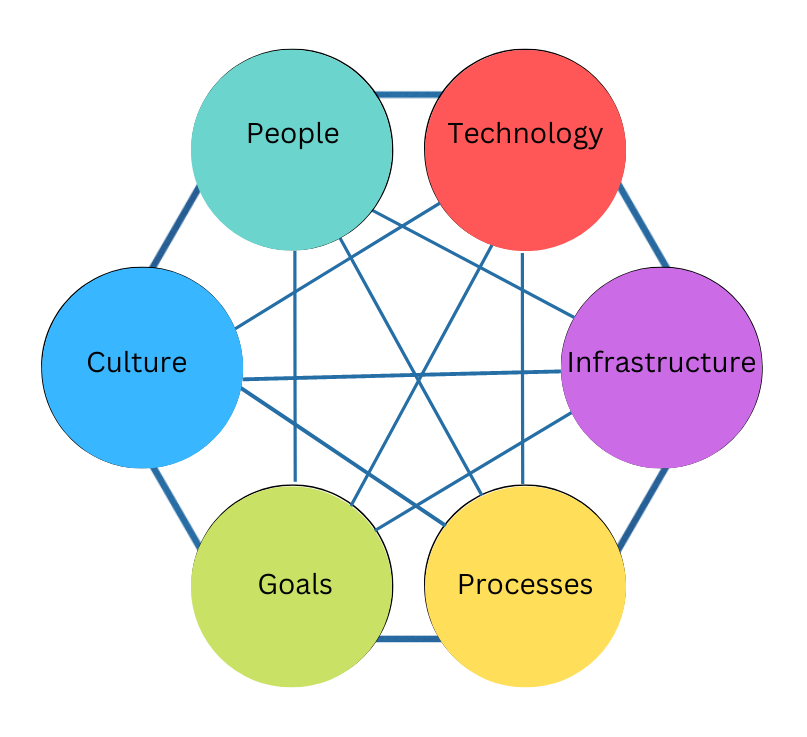by June Kaminski, RN MSN PhD(c) Editor in Chief
Citation: Kaminski, J. (2022). Editorial. Theory applied to informatics: Socio-Technical Theory. Canadian Journal of Nursing Informatics, 17(3-4). https://cjni.net/journal/?p=10442

Editorial
The socio-technical theory was first developed in the 1950s by Eric Trist and Ken Bamforth (1951) for the Tavistock Institute in London, UK as a challenge to the common Tayloristic assembly-line, bureaucratic ways that technology was being implemented within coal-mining organizations. Rather than viewing technology and people as separate aspects within organizations, socio-technical theory proposed that both technology and people should be seen as synergistic aspects of an interwoven system. Humans were not mere corporate capital, hired to work mechanistically to tend a part of the machine, but worked best as a system of intelligent agents capable of innovation and making sound decisions to improve the workflow and processes. The notion of open systems introduced by Von Bertalanffy in 1950 was an important part of the emerging socio-technical theory.
However, at first, leaders of coal industry organizations balked at this new theory since it meant giving workers more control and autonomy. “They feared the power change that would be consequent on allowing groups to become more autonomous at a time when they themselves were intent on intensifying managerial controls in order to accelerate the full mechanization of the mines” (Trist, 1981, p. 14). Over time though, evidence accumulated that supported the theory, and reinforced that people and technology influenced each other within the workplace, and people must be considered and supported when technology was added to any system.
Eric Trist, one of the first scholars who continued to develop and refine the theory as technology advanced wrote about its impact and relevance to organizations and society at large in 1981. “As the historical process of a society unfolds individuals change their values and expectations concerning work roles. This changes the parameters of organizational design. Conversely, changes in technology bring about changes in values, cognitive structures, lifestyles, habitats, and communications which profoundly alter a society and its chances of survival. Socio-technical phenomena are contextual as well as organizational” (Trist, 1981, p. 11).
Trist (1981, p. 42) provided the following table (Table 1) to show the key characteristics of the new organizational paradigm proposed in the socio-technical theory that supported a high quality of work life for all employees. Trist (1981) further explained “Our traditional organizations follow the technological imperative which regards man simply as an extension of the machine and therefore as an expendable spare part. By contrast, the emergent paradigm is founded on the principle of joint optimization, which regards man as complementary to the machine and values his unique capabilities for appreciative and evaluative judgement. He is a resource to be developed for his own sake rather than to be degraded and cast aside. A society is no better than the quality of the people it produces” (p. 43).
Table 1: New Socio-Technical Paradigm (Trist, 1981)
| Old Paradigm | New Paradigm |
| The technological imperative | Joint optimization |
| People as an extension of the machine | People as complementary to the machine |
| People as an expendable spare part | People as a resource to be developed |
| Maximum task breakdown, simple narrow skills | Optimum task grouping, multiple broad skills |
| External controls (supervisors, specialist staffs, procedures) | Internal controls (self-regulating subsystems) |
| Tall organisation chart, autocratic style | Flat organisation chart, participative style |
| Competition, gamesmanship | Collaboration, collegiality |
| Organisation’s purposes only | Members’ and society’s purposes also |
| Alienation | Commitment |
| Low risk-taking | Innovation |
Socio-technical Dimensions or Subsystems
Generally, the socio-technical system consists of three main dimensions or subsystems: the social, technical, and environmental (Figure 1). The social subsystem is the “individuals or people that constitute an organisation and the relationships, values, structure, work-related elements and associations that are delivered by organisational members” (Abbas & Michael, 2022, p. 4). The technical subsystem includes the technology, machines, and “… the tools, techniques, skills, and devices that are required by workers to fulfil organisational objectives and tasks” (p. 4). The environmental subsystem enfolds the social and technical subsystems and “is defined as the context, surroundings, and conditions within which the open socio-technical system operates and is situated, referring to both the internal and external environment” (p. 4).
Figure 1: Socio-Technical Dimensions-Subsystems
Ideally, thought and resources are applied to ensure all three subsystems interact together smoothly and harmoniously. “The technical and social systems are independent of each other in the sense that the former follows the laws of the natural sciences while the latter follows the laws of the human sciences and is a purposeful system. Yet they are correlative in that one requires the other for the transformation of an input into an output, which comprises the functional task of a work system. Their relationship represents a coupling of dissimilars which can only be jointly optimised. Attempts to optimise for either the technical or social system alone will result in the suboptimisation of the socio-technical whole” (Trist, 1981, p. 24).
Chris Clegg (1979, 2000) created a hexagonal schema that further differentiated the social and technical subsystems as they were enacted within the environmental subsystem. “This hexagonal socio-technical framework conceptualizes work as a complex system, comprising both socio elements – people, culture, and goals (the left side) – and technical elements – technology, infrastructure, and processes (the right side). Changes in any one element, or node, will cause and necessitate changes elsewhere in the system due to its complex interactive nature, as illustrated by the nodes’ interconnecting lines representing causal relationships” (Clegg et al., 2017, p. 1).
Figure 2: Hexagonal socio-technical systems framework (Clegg, 1979, Clegg et al., 2017)
Socio-technical theory and Informatics
At the time of Trist’s 1981 publication, computers and information and communication technologies (ICTs) were just beginning to gain popularity and were slowly being adopted by organizations. He did however spend some time considering the possibilities of these new technologies and applied the socio-technical theory to his musings, declaring that if adopted wisely, ICTs could introduce a new democratization in the workplace and in society. “If a bureaucratic paradigm were followed, the danger is that a form of corporatism might emerge which would lead in a totalitarian direction. The new institution-building task is to discover an alternative route based on participative and democratic principles which can secure inter-organizational collaboration” (p. 54). Trist encouraged leaders and designers to focus on networks and collaborative ways to harness the new promising technologies to strengthen organizational and societal open systems where the social and technical subsystems were optimized within a supportive and resource-rich environmental system. All humans affected by the technology should be considered since “socio-technical systems design valued not just the end user but all operational and nonoperational stakeholders” (Abbas & Michael, 2021, p. 57).
Since its advent, the socio-technical theory has been applied to many research studies in a variety of disciplines, including the health professions (Lin et al., 2016; Booth et al., 2017). Adaba and Kebebew (2018) described how they applied socio-technical system (STS) theory through action research to improve hospital information system design. “Information systems design and implementation is a complex and challenging endeavor that has both technical and social dimensions and requires changes in the behavior of actors, social structures, culture, and processes to succeed. Thus, adopting an STS perspective is essential to increase the chances of success by taking into consideration both technical, social, and organizational factors and the interactions between various actors in the healthcare environment” (p. 160). The authors rationalized that socio-technical theory is crucial to any system design since up to 90% of system implementations fail or are substandard since the human or social side of the endeavour was not carefully considered and included in the design: this omission often leaves many systems unusable or at a minimum, inadequate. System users must be placed at centre-stage of any viable design, “…to mimic the organization and distribution of work, workflow processes, and cooperative work procedures” (p. 165) and “it was necessary for the PAS [Patient Administration System} to reflect the patient’s journey through the department’s three units” (p. 165).
Bednar & Welch (2020) studied the place of socio-technical theory in the context of contemporary smart remote and virtual workplaces and emphasized the need to focus on both the social and the technical aspects of system design simultaneously to overcome “challenges involved in design of flexible, dispersed organizational systems to promote creativity and autonomous, continual innovation” (p. 290). The authors encouraged a contemporary version of the socio-technical theory to move beyond improving work life for the people involved, to “…focus on achievement of excellence and sustainable systems” (p. 291) and concluded with “We suggest that contemporary, open, socio-technical systems perspectives are needed, harnessing appropriate tools and techniques to ensure that systems are created that are meaningful to all engaged actors” (p. 295).
Cherry (2021) reinforced this perspective and described how solutions to working during the COVID pandemic provided fertile testing grounds for this approach. “A silver lining of the Covid Pandemic could be the rise in STS awareness as organizations quickly sent home entire workforces and figured out how to manage their businesses in a remote environment. For example, Zoom saw its February-April 2020 quarter revenue increase over double than the same quarter in 2019, $328 million to $122 million. This dramatic increase indicated the awareness of leveraging technical tools to support productivity, social connection, and team continuity” (p. 7). This extended to the rapid uptake of telehealth use to continue healthcare visits and consultations, as well as education, where technology was used to provide virtual classrooms as students were isolated to protect them from exposure to the virus. The application of socio-technical theory to these changes could lead to improved quality of work and school life, and reduced stress (Guest et al., 2022). “Sociotechnical systems are an effective way to bring technology and people together while managing risks and improving the human experience of today’s technologies” (Lucid Content Team, n.d., p. 1).
Booth et al., (2017) applied the socio-technical theory to design systems for nursing education simulation of medication administration systems. “In the case of healthcare, sociotechnical perspectives are generally used to explore how humans and health technology interact and operate within health environments, since all work practices are conceptualized as larger, interconnected networks of peoples, tools, objects, and routines. A sociotechnical lens enables an educator to question the role, importance, and influence of material objects such as technology in the learning or operation of specific tasks, including within clinician simulated education” (p. 132).
Lucid Content Team (n.d., p. 3) outlined distinct principles of applying socio-technical theory to contemporary systems design:
- Adaptability and system resilience: Sociotechnical systems prioritize adaptability. The organizational structure favored by sociotechnical theory is one that’s highly adaptable to change and flexible even in managing uncertainty.
- Responsible autonomy: Instead of placing responsibility solely with the individual contributor, sociotechnical theory focuses on the group or team level. Small, closely operating groups of team members who share responsibility and are able to collaborate together benefit from fewer silos and are often able to communicate more effectively.
- Whole tasks for entire lifecycles: Instead of moving one project through multiple teams throughout the project lifecycle, sociotechnical systems allow a single team to shepherd the project from start to finish. The group is able to be more flexible about resolving the task. Projects don’t become “someone else’s problem” but are champion-led by a team empowered with decision-making responsibilities.
- Meaningful tasks: Because teams have ownership of tasks and start-to-finish responsibilities, these tasks retain their meaning and provide closure for everyone involved.
These principles have been applied by many organizations over the years to improve the socio-technical climate and improve quality of work. “The core principles of responsible autonomy, adaptability, and meaningful tasks were taken up by a large number of organisations” (Walker, 2015, p. 176)
Carl Macrae (2022) examined how socio-technical theory can inform the development of autonomous and intelligent systems (AIS) such as robots and self-driving cars so that society can reap the benefits and reduce the risks of using these types of technologies. “Five fundamental domains of sociotechnical risk were conceptualized—structural, organizational, technological, epistemic, and cultural—each indicated by particular patterns of sociotechnical failure. The resulting SOTEC framework of sociotechnical risk in AIS extends existing theories of risk in complex systems and highlights important practical and theoretical implications for managing risk and developing infrastructures of learning in AIS” (p. 1999). Mohamed et al., (2020) went further to apply critical decolonial theory as a lens to provide socio-technical insight into the use of artificial intelligence (AI), by examining how AI development can impact already vulnerable groups of people.
Guy Walker (2015) mused that although socio-technical theory is considered old, it is still a theory worth applying seventy years after its first emergence in the literature to help organizations to meet human needs when implementing technology. “Sociotechnical systems (STS) theory was an approach developed to address these matters. Several large firms embraced the principles to give rise to organisations that were highly adaptable, flexible, responsive, and above all resilient. What we have in STS theory is a powerful demonstration of how to harness the emergent edge-of-chaos properties of humans, jointly optimised with engineering, which could offer a radical new approach to resilience” (p. 170). It seems that socio-technical theory is a well-established, classic yet timely theory that can be applied to a myriad of development and implementation environments, including healthcare. It is a theory worthy of inclusion in any informatics related research, practical application of technology in the workplace, as well as the use of technology in our daily lives.
References
Abbas, R. & Michael, K. (2022). Socio-Technical Theory: A review. In S. Papagiannidis (Ed), TheoryHub Book. https://open.ncl.ac.uk/theories/9/socio-technical-theory/
Abbas, R. & Michael, K. (2021). Socio-Technical Design for Public Interest Technology. IEEE Transactions on Technology and Society, 2(2), 55-61. https://ieeexplore.ieee.org/stamp/stamp.jsp?arnumber=9459499
Adaba, G. B., & Kebebew, Y. (2018). Improving a health information system for real-time data entries: An action research project using socio-technical systems theory. Informatics for Health & Social Care, 43(2), 159–171.
Bednar, P.M., Welch, C. (2020). Socio-Technical Perspectives on Smart Working: Creating Meaningful and Sustainable Systems. Information Systems Frontiers, 22, 281–298 https://doi.org/10.1007/s10796-019-09921-1
Booth, R. G., Sinclair, B., Brennan, L., & Strudwick, G. (2017). Developing and Implementing a Simulated Electronic Medication Administration Record for Undergraduate Nursing Education: Using Sociotechnical Systems Theory to Inform Practice and Curricula. Computers, Informatics, Nursing: CIN, 35(3), 131–139.
Cherry, M. (March 4, 2021). Socio-Technical Systems: Change Management in a Pandemic. Lewis University Expert Blogs. https://www.lewisu.edu/experts/wordpress/index.php/socio-technical-systems-change-management-in-a-pandemic/
Clegg, C. W. (1979). The Process of Job Redesign: Signposts from a Theoretical Orphanage? Human Relations, 32(12), 999–1022.
Clegg C. W. (2000). Sociotechnical principles for system design. Applied ergonomics, 31(5), 463–477. https://doi.org/10.1016/s0003-6870(00)00009-0
Clegg, C., Robinson, M., Davis, M., Bolton, L., Pieniazek, R., & McKay, A. (2017). Applying organizational psychology as a design science: A method for predicting malfunctions in socio-technical systems (PreMiSTS). Design Science, 3, E6. doi:10.1017/dsj.2017.4
Guest, D., Knox, A., & Warhurst, C. (2022). Humanizing work in the digital age: Lessons from socio-technical systems and quality of working life initiatives. Human Relations, 75(8), 1461–1482.
Lin, C.-P., Guirguis-Blake, J., Keppel, G. A., Dobie, S., Osborn, J., Cole, A. M., & Baldwin, L.-M. (2016). Using the diffusion of innovations theory to assess socio-technical factors in planning the implementation of an electronic health record alert across multiple primary care clinics. Journal of Innovation in Health Informatics, 23(1), 450–458.
Lucid Content Team. (n.d.). The importance of sociotechnical systems. Lucid Chart. https://www.lucidchart.com/blog/sociotechnical-systems
Macrae, C. (2022). Learning from the Failure of Autonomous and Intelligent Systems: Accidents, Safety, and Sociotechnical Sources of Risk. Risk Analysis: An International Journal, 42(9), 1999–2025.
Mohamed, S., Png, M.-T., & Isaac, W. (2020). Decolonial AI: Decolonial Theory as Sociotechnical Foresight in Artificial Intelligence. Philosophy & Technology, 33(4), 659–684.
Trist, E. L., & Bamforth, K. (1951). Some social and psychological consequences of the Longwall Method of coal-getting: An examination of the psychological situation and defences of a work group in relation to the social structure and technological content of the work system. Human Relations, 4, 3-38.
Trist, E. (1981). The Evolution of Socio-technical Systems: A Conceptual Framework and an Action Research Program. Occasional Paper No. 2. Ontario Ministry of Labour, Ontario Quality of Working Life Centre.
Von Bertalanffy, L. (1950). An outline of general system theory. British Journal for the Philosophy of Science, 1, 134–165. https://doi.org/10.1093/bjps/I.2.134
Walker, G. (2015). Come back sociotechnical systems theory, all is forgiven …. Civil Engineering & Environmental Systems, 32(1/2), 170–179.







